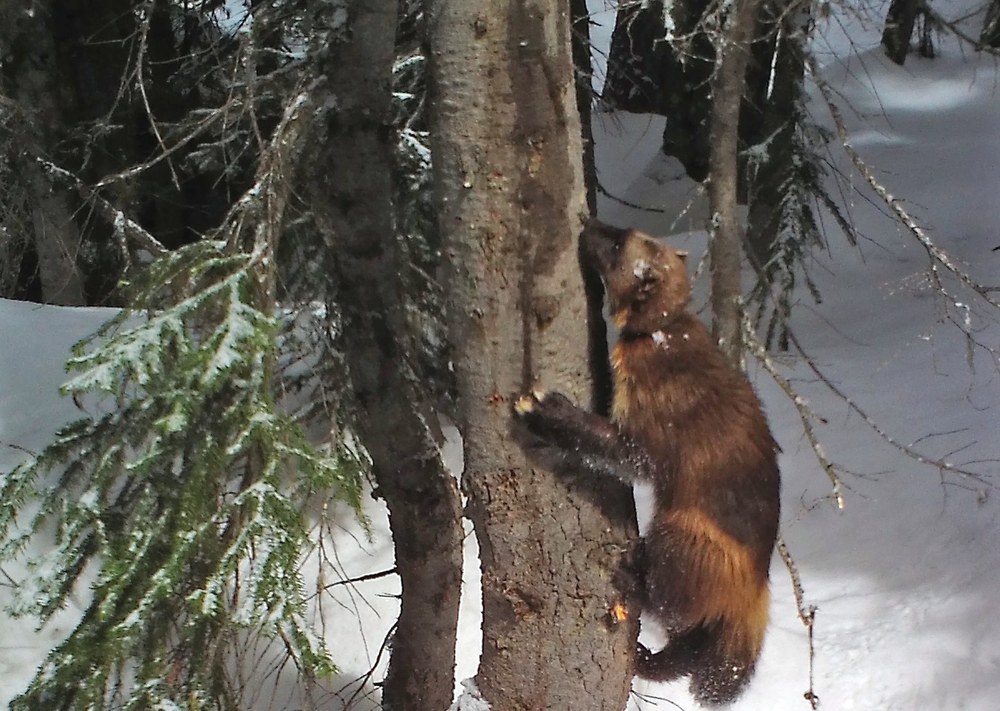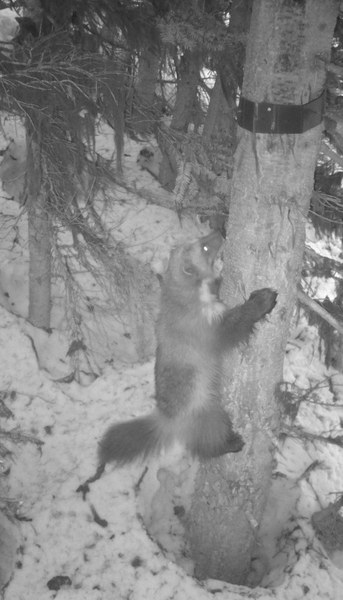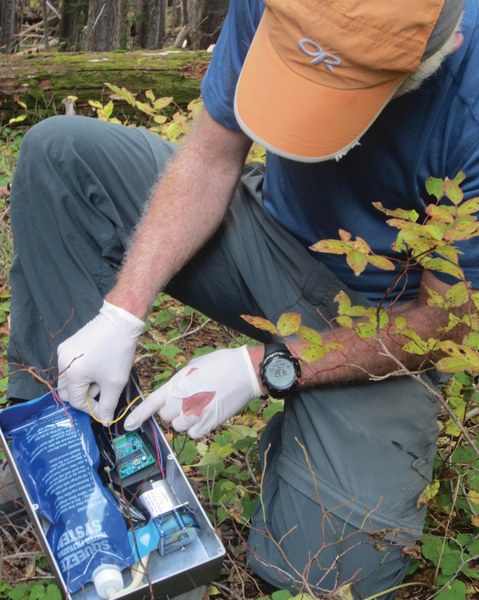
The chances of seeing a wolverine in the North Cascades are low but no longer zero, thanks to the intrepid animal’s return from Canada.
Wolverines (Gulo gulo) disappeared from the Cascades in the early 1900s after being hunted, trapped, and poisoned into extinction in the lower 48 states. For the next 100 years, the animal appeared only a handful of times in the Cascade mountains until 2012, when researchers discovered an active wolverine den in Washington state, suggesting that wolverines are re-establishing territory in the Pacific Northwest. With the wolverines’ return, scientists are eager to learn more about these elusive creatures.
Wolverines are the largest land-dwelling member of the weasel family, which includes European badgers, stoats, and otters. Adults weigh between 20 and 55 pounds but can take down a deer or elk under the right circumstances. They dwell in high alpine environments and thrive in deep snow, which females use to build dens for birthing their “kits” in late February to early March. During spring, a persistent snowpack is essential for the dens, which keep kits insulated and safe from predation. To find food, wolverines travel extensive distances until their keen sense of smell detects carcasses (either on the ground’s surface or buried beneath snow, depending on the season) or small mammals such as squirrels, marmots, and hares to catch and kill.
 A wolverine attracted by a scent bait lure is captured on film with a nearby, motion-sensitive camera set.
A wolverine attracted by a scent bait lure is captured on film with a nearby, motion-sensitive camera set.
An important piece of wolverine research is observing how they move across the landscape. “Wolverines are built to move,” said Robert Long, senior conservation scientist at the Woodland Park Zoo. “They are tenacious and tough and avoid people at all costs.” At least one wolverine has a range the size of Rhode Island and regularly travels between Washington state and British Columbia.
Observing the movement patterns of wolverines can help researchers understand how best to support the return of these rare carnivores, which were listed as threatened under the Endangered Species Act in 2023. However, due to their elusive nature, observation can be challenging.
“Wolverines live in rugged, hard-to-access places,” said Long. To gather information on wolverine behavior, he and conservation specialist Paula MacKay work with a network of local, state, and national governments; nonprofit organizations; Native American tribes; and other groups to study wolverines in their natural habitats.
 A researcher sets up an automatic scent dispenser. These dispensers allow more time in between researcher revisits to wolverine dwelling sites.
A researcher sets up an automatic scent dispenser. These dispensers allow more time in between researcher revisits to wolverine dwelling sites.
“We’ve collected hundreds of wolverine observations, which we hope to use to show people how alive the wilderness is, even in the winter,” said Stephanie Williams, a mountain guide and field biologist who co-founded the Cascades Wolverine Project in 2017.
Most of the observations come from camera “traps” in remote, high alpine regions. The traps consist of bait, such as animal carcass parts enhanced with other smells to attract wolverines. Williams and her team (who have collective experience as backcountry mountain guides and avalanche forecasters) spend winters trekking into the backcountry with animal parts to re-bait traps.
More recently, Long, MacKay, and others worked with Microsoft to develop automated scent dispensers for the camera traps. The ingredients for these scent dispensers include liquid beaver castoreum oil, pure skunk extract, and fish oil, as well as propylene glycol and water which reduce the freezing point to -40 degrees Celsius so the lures function throughout winter.
 Robert Long, Senior Conservation Scientist and Director, Living Northwest Program, Wildlife Conservation, at the Woodland Park Zoo, climbs a tree to deploy a scent dispenser designed to attract wolverines.
Robert Long, Senior Conservation Scientist and Director, Living Northwest Program, Wildlife Conservation, at the Woodland Park Zoo, climbs a tree to deploy a scent dispenser designed to attract wolverines.
The population of wolverines in the North Cascades is currently estimated to be around twenty-five. According to Long and Williams, Mountaineers interested in wolverine conservation can help in significant ways:
Report sightings or tracks. Wolverines have five toes on their front and hind feet. Sometimes mistaken for lynx, wolf, or pine marten, wolverine tracks can range from 3.5 to 7 inches long and 3 to 5 inches wide. If you see a wolverine or encounter tracks, you can contribute to science by submitting your wildlife observation at CascadesWolverineProject.org or by emailing info@CascadesWolverineProject.org. Be sure to record the time, date, and location of your sighting, and take a photograph of the trail pattern and the tracks with something to compare for scale, such as a ski pole or your hand.
Be aware of your environmental impact, in the mountains and at home. “Wolverines are a species we could lose if humans don’t slow down the effects of climate change,” Long said. “We can make choices that make their disappearance less likely.” In the mountains, lessening our impact could involve avoiding areas where wolverines have dens. At home, it might involve advocating for policies that protect wolverine habitats and reduce the impacts of climate change. “We can all play a role in correcting course,” said Williams. “You just need to take the small steps that you are able to do.”
Melissa Lutz Blouin is a science writer, hike leader, outdoorswoman, and RYT200-hour yoga instructor based in Mill Creek, Washington. Visit her online at MelissaLutzBlouin.com and follow her on Instagram @melissimawritesandmoves.
This article originally appeared in our spring 2025 issue of Mountaineer magazine. To view the original article in magazine form and read more stories from our publication, visit our magazine archive.
 Melissa Blouin
Melissa Blouin